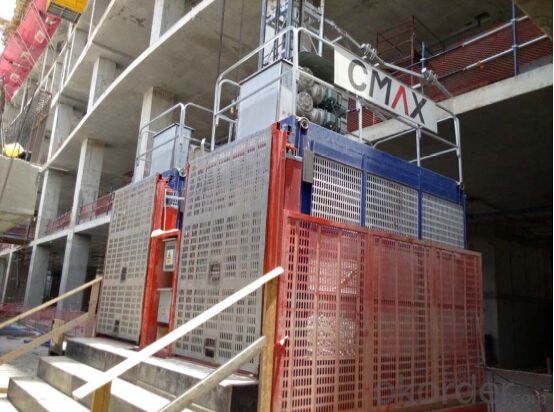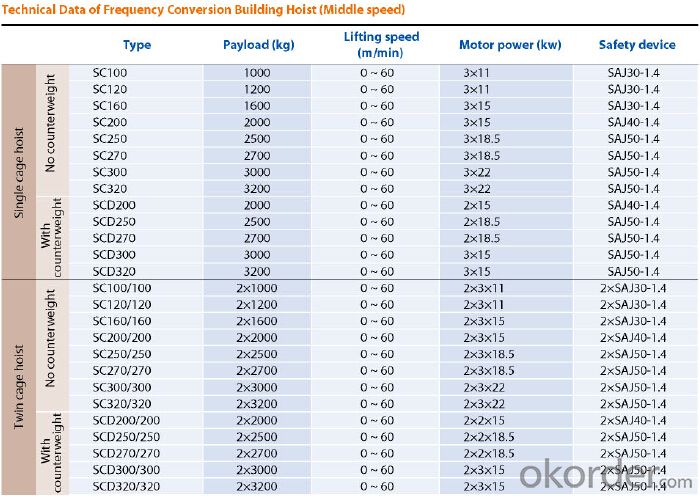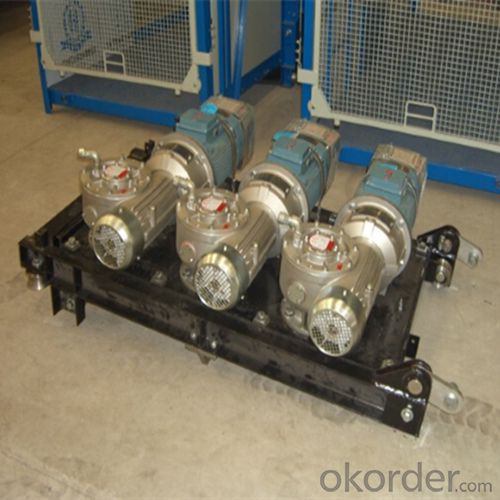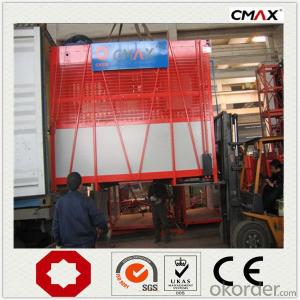Building Hoist Counterweight SCD270 Hot Sale
- Loading Port:
- China main port
- Payment Terms:
- TT or LC
- Min Order Qty:
- 1 unit
- Supply Capability:
- 30 unit/month
OKorder Service Pledge
OKorder Financial Service
You Might Also Like
Structure of Building Hoist Description
1.Feature: Building Hoist
2.Condition: New
3.Application: Construction
4.Payload(kg):2700
5.Lifting Speed(m/min):0~60
6.Motor Power(kw): 2*18.5
7.Safety Device: SAJ50-1.4
8.Cage: Single
9.Counterweight: Yes
10.Certification: CE,ISO
11.Place of Origin: China(Mainland)
12.Model Number: Type:SCD270
Packaging & Delivery of Building Hoist
Packaging Detail: Nude package Delivery Detail: 25-30days
Main Parts of Building Hoist
● Adopts the most advanced VF speed control device and microcomputer programmable logic controller.
● Stepless speed control helps eliminate the concussion during start up and braking, steady the operation process and ensures automated leveling.
● Adopts open loop V/Fcontrol; the speed control precision can reach ±2~3%. Realizes accurate low speed positioning of the hoist and avoid slipping during downward stopping of hoist.
● The VF system has current-restriction function, ensuring a small current when motor start up and reducing the concussion to power supply. It reduces the engery consumption and mitigates effects to on site electric equipments.
● The steadiness during running mitigates concussion to mechanical parts, reduces wears of rack, pinion and the brake and prolongs the spare parts'life.
● The VF system also has the over voltage protection,low voltage protection, overcurrent, overload and anti-stalling protection functions,
● The system applies the special software for hoists developed by our company, making the operation more safe and reliable.
Building Hoist Images
CMAX Building Hoist

Anchorage System

Mast Section

Driving Unit

Building Hoist Specifiction

FAQ of Building Hoist
Q: What is the building hoist main purpose?
A: Building hoist equipped with double or single cabin to transport the materials and labors up and down. It's the ideal construction equipment for vertical transportation in the field of construction.
Q: What is the main structure of building hoist?
A: The P/M construction hoist mainly contains metal structure, driving system, electrical control system, cable guide & protection system, electrical top crane and safety device.
Q: What is the meaning of the building hoist’s code?
A: Take SC200/200 for example: “SC” stands for rack and pinion hoist, “200/200” stands for double cage and capacity is 2 tons per cage. “SC200” stands for single cage and capacity is 2 tons.
Q: What is the dimension of the cage?
A: Normally the cage dimension is 3X1.5X2.5M (L/W/H) for 2t type hoist. Details should be checked according to our
quotation sheet. Also, the size can be customized according to the factual site condition. There are two doors (entrance& exit doors) for each cage, It can be produced as up & down sliding or ramping model for safety and convenience.
- Q: What about the energy efficiency of the escalator
- Variable frequency construction elevator energy saving effect general. Frequency conversion is not energy efficient. The difference between the frequency and the common machine is the smoothness and speed of the operation. Frequency conversion speeds up to 90m / 1 minutes and the average is only 35m / 1 min Frequency conversion when parking is slow down and stop Ordinary is directly stop delay parking and adjustment made door light who bow Angle decyl with brush spring connection will be better. The frequency conversion requires the site voltage to be strictly a little bit looser than the voltage requirement Energy consumption is: according to the elevator drive mechanism for general three transmission two kinds of the elevator are three 11 kw motor, that their energy consumption are 3 x 11 = 33 kw is hours each hanging basket consumes electricity 33 degrees, the actual power consumption will be bigger.
- Q: This question asks if single-rope lifts can experience malfunctions or create safety risks.
- <p>Yes, single-rope lifts can malfunction and pose safety hazards. Like any mechanical system, they are subject to wear and tear, component failure, and human error. Factors such as inadequate maintenance, poor weather conditions, and operator negligence can lead to malfunctions. Safety hazards may include rope breakage, sudden stops, or even derailment. However, modern lifts are equipped with multiple safety features such as emergency brakes and redundant systems to minimize these risks and ensure passenger safety. Regular inspections and adherence to safety protocols are crucial to prevent malfunctions and maintain the safety of single-rope lifts.</p>
- Q: This question asks for the cost associated with purchasing and installing a building hoist.
- <p>The cost of buying and installing a building hoist can vary significantly depending on several factors. The type and capacity of the hoist, the height of the building, and the complexity of the installation are key determinants. On average, the cost can range from $10,000 to $50,000 for the hoist itself, with installation costs potentially adding another 20-50% to the total. However, for very tall buildings or specialized hoists, the price can exceed $100,000. It's crucial to obtain quotes from multiple suppliers and installers to get an accurate estimate for your specific project.</p>
- Q: Is it possible to integrate a single-rope lifting mechanism into an electric-hydraulic lifting system?
- <p>Yes, a single-rope lifting system can be used in an electric-hydraulic lifting system. The electric-hydraulic system provides the power to lift and lower the load, while the single-rope system manages the vertical movement of the load. This combination allows for precise control and can be advantageous in applications requiring both the lifting capacity of hydraulics and the simplicity of a single-rope system. However, the design must ensure compatibility between the mechanical and hydraulic components to function effectively and safely.</p>
- Q: What's going on with the decline in construction lift
- Check to see if there is any problem with holding the brake. There is no problem with the contactless contactor, which is the most common cause of the vehicle. Normal contactor will rebound at the moment of you to stop operation, adhesion would be stuck there for a few seconds and then bounce back, in a few seconds the brake coil is charged, the brake is still in open state, but the motor has stopped working, so will decline, it's adhesion change the same contactor change.
- Q: What are the pros and cons of utilizing hydraulic fluid within the system of a building hoist?
- <p>The advantages of using hydraulic fluid in a building hoist include smooth and controlled lifting, which reduces the risk of accidents. It also offers a compact design due to the high power-to-weight ratio of hydraulic systems. Additionally, hydraulic systems are known for their durability and low maintenance requirements. However, there are disadvantages such as the potential for leaks, which can be hazardous and costly to repair. The systems can also be sensitive to temperature changes, which might affect performance. Lastly, hydraulic fluids can be environmentally harmful if not properly managed, posing disposal challenges.</p>
- Q: What are the necessary conditions and safety measures to be met when using a building hoist to lift heavy objects?
- <p>Lifting heavy objects with a building hoist requires adherence to several key requirements for safety and efficiency. These include ensuring the hoist is properly installed and inspected, the load is secured correctly, and the weight does not exceed the hoist's capacity. Operators must be trained and certified, and they should follow all safety protocols. The area around the hoist should be clear of obstructions and bystanders. Regular maintenance and checks are crucial to prevent accidents. Additionally, weather conditions, such as high winds, can affect the safety of hoist operations and may require postponing lifts until conditions improve.</p>
- Q: This question asks if a building hoist can be set up either inside or outside a building.
- <p>Yes, a building hoist can be installed both indoors and outdoors. The choice between indoor and outdoor installation depends on the specific requirements of the construction project, the available space, and the building's design. Outdoor hoists are often used for high-rise construction, while indoor hoists are more common in multi-story buildings or where external space is limited. Both types require careful planning and adherence to safety regulations to ensure the safe and efficient movement of materials and personnel.</p>
- Q: Is it possible to use a building hoist to lift multiple objects simultaneously?
- <p>Yes, it is possible to use a building hoist to lift multiple objects at once, provided the total weight of the objects does not exceed the hoist's load capacity. It's important to ensure that the objects are securely fastened to prevent any from falling. Additionally, safety protocols should be followed to avoid overloading the hoist, which can lead to mechanical failure or accidents. Always consult the hoist's specifications and safety guidelines before lifting multiple objects.</p>
- Q: Is it possible to utilize a building hoist for the transportation of heavy objects?
- <p>Yes, a building hoist is specifically designed to move heavy objects within a construction site or in similar environments. It is a type of crane that can lift and lower materials vertically, making it ideal for transporting heavy items such as construction materials, machinery, and equipment. Building hoists are engineered to handle significant weight loads and are an essential tool for efficient material movement in vertical construction projects.</p>
Send your message to us
Building Hoist Counterweight SCD270 Hot Sale
- Loading Port:
- China main port
- Payment Terms:
- TT or LC
- Min Order Qty:
- 1 unit
- Supply Capability:
- 30 unit/month
OKorder Service Pledge
OKorder Financial Service
Similar products
Hot products
Hot Searches
Related keywords






























